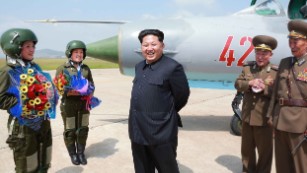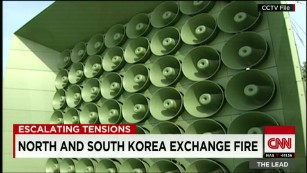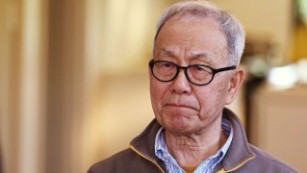Korean crisis: What's behind the North-South tension? 01:47
Story highlights
- North, South Korea at odds again after landmine incident on DMZ, South Korean military exercises
- Pyongyang threatened to blow up South Korean propaganda loudspeakers at the border
- But tensions between the two neighbors -- who are technically still at war -- ebb and flow
(CNN)Here we go again.
After
another war of words, and an exchange of fire
across the world's most
fortified border, the two Koreas appear to be set on a collision course.
South
Korea is angry at its unpredictable neighbor's provocations, while Kim
Jong Un has placed his front-line forces on a war footing. But haven't
we seen this before?
We look behind the scenes of this fractious relationship.
What happened this time?
On
Thursday, the two sides traded artillery fire over the demilitarized
zone -- though no casualties were reported by either side.
Pyongyang
hasn't explained its part in the incident, but a statement last week
from the state-run KCNA new agency accused South Korea of committing a
"military provocation."
Seoul,
meanwhile, has accused the North of planting landmines deliberately in
the path of its patrols in the demilitarized zone after two soldiers
were seriously wounded earlier this month. North Korea has denied the
allegation.
And if this wasn't enough, a
massive military exercise involving South Korea, the United States and a
host of other allies is underway, which North Korea says it views as a
prelude to an invasion. It has threatened to retaliate against the U.S.
"with tremendous muscle."
According
to the U.S. military, the purpose of the multinational exercise --
named Ulchi Freedom Guardian -- is "to enhance ... readiness, protect
the region and maintain stability on the Korean peninsula."
Should we be worried about this latest escalation?
Tensions
between the two neighbors -- who are technically still at war -- ebb
and flow. Earlier this year, an annual exercise between South Korean and
U.S. forces, involving thousands of troops and state of the art
military hardware, didn't go down well with North Korea. It fired two
short-range ballistic missiles into the East Sea, also known as the Sea
of Japan, after slamming the exercises as "dangerous nuclear war drills
for invading the DPRK."
Leader Kim Jong Un then called for full combat readiness and oversaw military facilities, according to KCNA.
"The
North Koreans, being paranoid in their own way, have always had this
concern: 'If there is going to be an invasion, this would be the time,'"
said Philip Yun, executive director of the Ploughshares Fund, a group
that advocates nuclear disarmament. "But that's not the intent on the
U.S.-South Korean side."
This
time around, North Korea appeared to shoot at loudspeakers the South
had set up along the DMZ blaring out propaganda in the wake of the
landmines incident, prompting a retaliation from South Korean forces.
Pyongyang had previously threatened to blow up the speakers and warned
of "indiscriminate strikes."
"North
Korea is especially sensitive about propaganda from South Korea,"
explained CNN's Seoul producer, KJ Kwon. "They've even shot at balloons
carrying leaflets critical of Pyongyang that activists have floated
across the border."
So this isn't war then?
Unlikely.
North Korea usually responds to "provocations" such as military drills
with angry rhetoric and perhaps a weapons test. Messages of impending
doom and the firing of short-range rockets or missiles into the sea tend
to become routine as the military exercises approach. "Their response
is carefully calculated to convey a particular message," said Kwon.
And that message is not always intended for its enemies abroad.
According
to Yun of the Ploughshares Fund, playing up the threat from the U.S.
helps the North Korean leadership's propaganda efforts to control the
population of the isolated nation.
For
now, the North is unlikely to push things any further. "According to
analysts in South Korea, they might move massive numbers of troops
closer to the border and then retreat, just as a provocation," said
Kwon.
What next?
Predicting
the secretive North Korean regime's next move is a notoriously
difficult game. Though tensions may not reach 2013 levels when
long-range rocket tests and its third nuclear test earned it tougher
United Nations sanctions. Pyongyang responded by ramping up its threats
of nuclear war against South Korea and the United States.
One North Korean government website even uploaded a YouTube video showing an imaginary missile attack on Washington.
The U.S. decision to fly B-2 stealth bombers, which
are capable of carrying nuclear weapons, over the region only served to
further antagonize North Korea amid the annual military drills.
"That
was a really bad escalation of the tensions in the Korean peninsula,"
Tong Kim, a visiting scholar at the U.S.-Korea Institute, part of Johns
Hopkins University, said of the period.
But
Pyongyang's decision to carry out the rocket launch and nuclear test
were most likely carefully timed, according to Yun, who was part of U.S.
teams that negotiated with North Korea under former President Bill
Clinton.
"They game everything out.
They don't do things off the cuff for the most part," he said of the
North Koreans. "If they're going to do something very provocative, they
have an extensive decision tree laying out many options."
The
moves appeared to be aimed at advancing North Korea's technology and
making Kim, still a relatively new leader, look strong inside the
country, Yun said. They also coincided with political transitions in
South Korea, China and Japan.
The 'Kim factor' -- more dangerous than his father?
Kim
Jong Un is "similar in action but stronger in rhetoric" than his
father, Tong Kim said. "Except that North Korea under Kim Jong Un has
newer and more formidable weapons."
Some of the techniques seen under Kim certainly recall those employed during his father's rule.
During
the tensions in early 2013, North Korea declared that the armistice
agreement that halted the Korean War in 1953 was no longer valid.
The
announcement sounded unsettling, but North Korea had already said in
2009 that its military was no longer bound by the armistice because
South Korea was joining a U.S.-led anti-proliferation plan.
In
2013, the North also tried using the silent treatment, cutting off a
military hotline with the South. That was similar to an approach it had
adopted in 2009 when it stopped responding to calls after the military
exercises started.
But during 14 years
of Kim Jong Il's rule, the United States and South Korea "had a track
record of what North Korea would do and a sense of what to expect," Yun
said. "Kim Jong Un was new, you didn't know how far he would go, which
added to the uncertainty."
Troubled history?
After
Japan's defeat in World War II, Korea became a divided nation, the
capitalist South supported by the United States and its Western allies
and the communist North an ally of the Soviet Union.
Cold
War tensions erupted into war 1950, devastating the peninsula and
taking the lives of as many as two million people. The fighting ended
with a truce, not a treaty, and settled little.
Besides
the border skirmishes, other incidents also have proved provocative. In
1968, North Korea dispatched commandos in an unsuccessful attempt to
assassinate South Korea's President.
In 1983, a bombing linked to Pyongyang killed 17 high-level South Korean officials on a visit to Myanmar.
In 1987, the North was accused of bombing a South Korean airliner.
And
in 2009, Seoul said a North Korean torpedo sent the warship Cheonan to
the bottom of the Yellow Sea off the South Korean-controlled island of
Baengnyeong. The sinking, also in the border area, killed 46 South
Korean sailors.






No comments:
Post a Comment